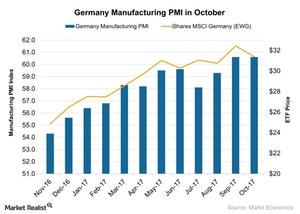What No Change in Germany’s Manufacturing PMI Could Mean for Its Economy
Germany’s final manufacturing PMI showed no change in October, coming in at 60.6, and meeting the preliminary market estimation of 60.5.
Nov. 8 2017, Updated 2:55 p.m. ET

Germany’s final manufacturing PMI in October
According to a report by Markit Economics, Germany’s final manufacturing PMI (purchasing managers’ index) showed no change in October 2017, coming in at 60.6—the same as in September 2017—and meeting the preliminary market estimation of 60.5.
The strong performance in Germany’s manufacturing PMI was mainly due to the following:
- improving production volumes and output in October (though at a slower pace)
- improving new business orders (though at a slow pace) in October and a stronger rate of growth for export orders
- faster rising employment in October—a six-year high
Performance of various ETFs in October
The iShares MSCI Germany ETF (EWG), which tracks the performance of Germany’s economy, rose 1.9% in October. The Vanguard FTSE Europe ETF (VGK), which tracks Europe’s (HEDJ) (EZU) (IEV) economic performance, rose only 0.5% in October.
This lack of change in Germany’s manufacturing PMI is signaling that although export orders are improving at a strong rate in October, domestic demand improved at a weaker pace that month. The gradual improvement in its manufacturing activity is a positive sign both for the Eurozone and Germany because Germany is the major manufacturing hub of the Eurozone.
In the next part, we’ll analyze Spain’s final manufacturing PMI for October 2017.
